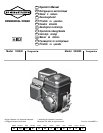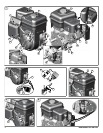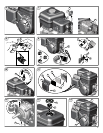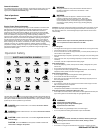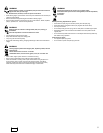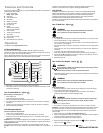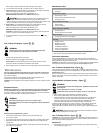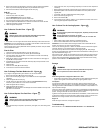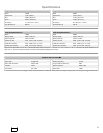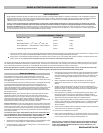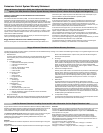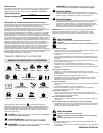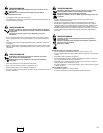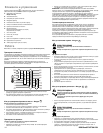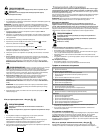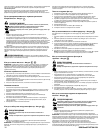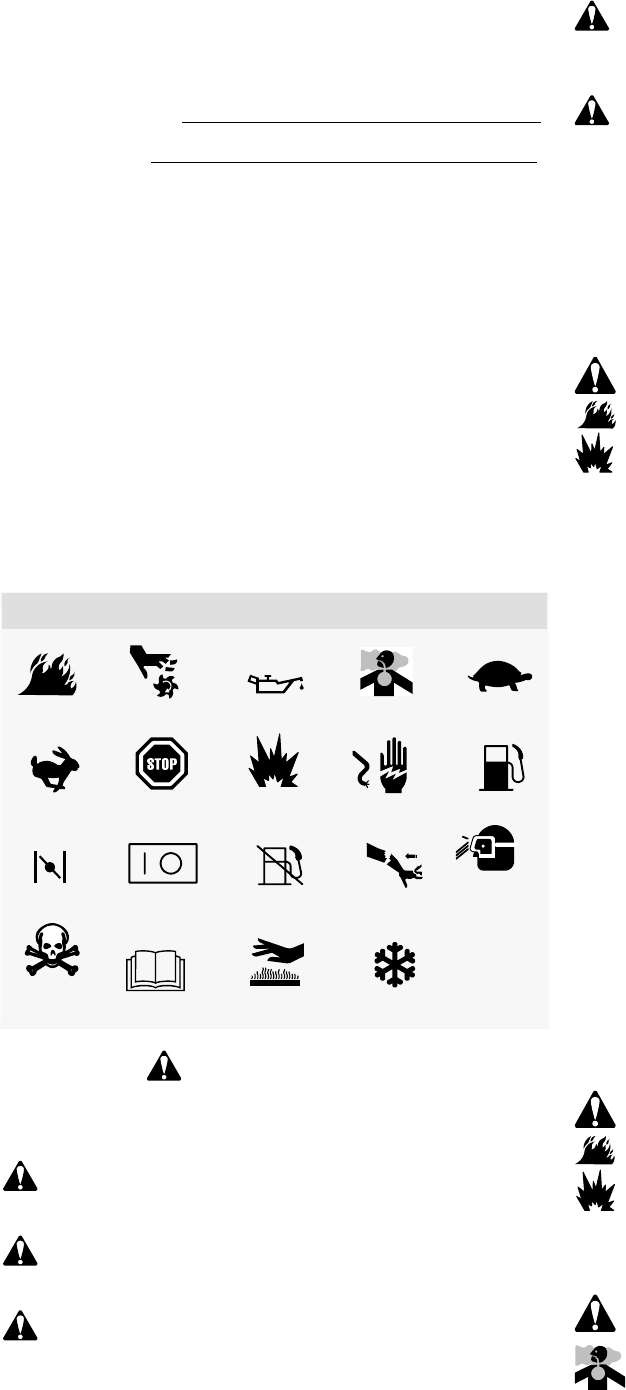
4 BRIGGSandSTRATTON.COM
General Information
For replacement parts or technical assistance, record below the engine model, t ype, and
code numbers along with the date of purchase. These numbers are located on your
engine (see the Features and Controls page).
Date of purchase:
Engine model:
MM/DD/YYYY
Model: Code:Type:
Engine Power Rating Information
The gross power rating for individual gas engine models is labeled in accordance with
SAE (Society of Automotive Engineers) code J1940 (Small Engine Power & Torque
Rating Procedure), and rating performance has been obtained and corrected in
accordance with SAE J1995 (Revision 2002-05). Torque values are derived at 3060
RPM; horsepower values are derived at 3600 RPM. Actual gross engine power will be
lower and is affected by, among other things, ambient operating conditions and
engine-to-engine variability. Given both the wide array of products on which engines are
placed and the variety of environmental issues applicable to operating the equipment,
the gas engine will not develop the rated gross power when used in a given piece of
power equipment (actual “on-site” or net power). This difference is due to a variety of
factors including, but not limited to, accessories (air cleaner, exhaust, charging, cooling,
carburetor, fuel pump, etc.), application limitations, ambient operating conditions
(temperature, humidity, altitude), and engine-to-engine variability. Due to manufacturing
and capacity limitations, Briggs & Stratton may substitute an engine of higher rated
power for this Series engine.
Operator Safety
Explosion
Toxic Fumes
Moving Parts
Shock
Hot Surface
Kickback
Fire
Fuel Shutoff
Read Manual
Choke
Oil
Fuel
On Off
Stop
Wear Eye
Protection
Slow
Fast
SAFETY AND CONTROL SYMBOLS
Hazardous
Chemical
Frostbite
The safety alert symbol
is used to identify safety information about hazards that can
result in personal injury. A signal word (DANGER, WARNING, or CAUTION) is used with the
alert symbol to indicate the likelihood and the potential severity of injury . In addition, a hazard
symbol may b e used to represent the type of hazard.
DANGER indicates a hazard which, if not avoided, will result in death or
serious injury.
WARNING indicates a hazard which, if not avoided, could result in death or
serious injury.
CAUTION indicates a hazard which, if not avoided, might result in minor or
moderate injury.
CAUTION, when used without the alert symbol, indicates a situation t hat
could result in damage to the product.
The engine exhaust from this product contains chemicals k nown to
the State of California to cause cancer, birth defects, or other
reproductive harm.
WARNING
Briggs & Stratton does not approve or authorize the use of these
engines on 3-wheel All Terrain Vehicles (ATVs), motor bikes,
fun/ recreational go-karts, aircraf t products, or vehicles intended for
use in competitive events. Use of these engines in such applications
could result in property damage, serious injury (including paralysis),
or even death.
WARNING
CAUTION: This engine was shipped from Briggs & Stratton without oil. Before you start
the engine, make sure you add oil according to the instructions in this manual. If you
start the engine without oil, it will be damaged beyond repair and will not be covered
under warranty.
WARNING
Gasoline and its vapors are extremely flammable and explosive.
Fire or explosion can cause severe burns or death.
When Adding Fuel
• Turn engine off and let engine cool at least2 minutes before removing the fuel cap.
• Fill fuel tank outdoors or in well -ventilated area.
• Do not overfill fuel tank. Fill tank to approximately 1.5 inches (38 mm) below top of
neck to allow for fuel expansion.
• Keep gasolineaway from sparks, openflames, pilot lights, heat,and other ignition
sources.
• Check fuel lines, tank, cap, and fittings frequently for cracks or leaks. Replace if
necessary
• If fuel spills, wait until it evaporates before starting engine.
When Starting Engine
• Ensure that spark plug, muffler, fuel cap and air cleaner (if equipped) are in place
and secured.
• Do not crank engine with spark plug removed.
• If engine floods, set choke (if equipped) to OPEN/RUN position, move throttle (if
equipped) to FAST position and crank until engine starts.
When Operating Equipment
• Do not tip engine or equipment at angle which causes gasoline to spill.
• Do not choke the carburetor to stop engine.
• Never start or run the engine with the air cleaner assembly (if equipped) or the air
filter (if equipped) removed.
When Changing Oil
• If you drain the oil from the top oil fill tube, the fuel tank must be empty or fuel can
leak out and result in a fire or explosion.
When Transporting Equipment
• Transport with fuel tank EMPTY or with fuel shut-off valve OFF.
When Storing Gasoline Or Equipment With Fuel In Tank
• Store away from furnaces, stoves, water heaters or other appliances that have pilot
light or other ignition source because they can ignite gasoline vapors.
Starting engine creates sparking.
Sparking can ignite nearby flammable gases.
Explosion and fire could result.
WARNING
• If there is natural or LP gas leakage in area, do not start engine.
• Do not use pressurized starting fluids because vapors are flammable.
Engines give off carbon monoxide, an odorless, colorless, poison gas.
Breathing carbon monoxide can cause nausea, fainting or death.
WARNING
• Start and run engine outdoors.
• Do not start or run engine in enclosed area, even if doors or windows are open.



